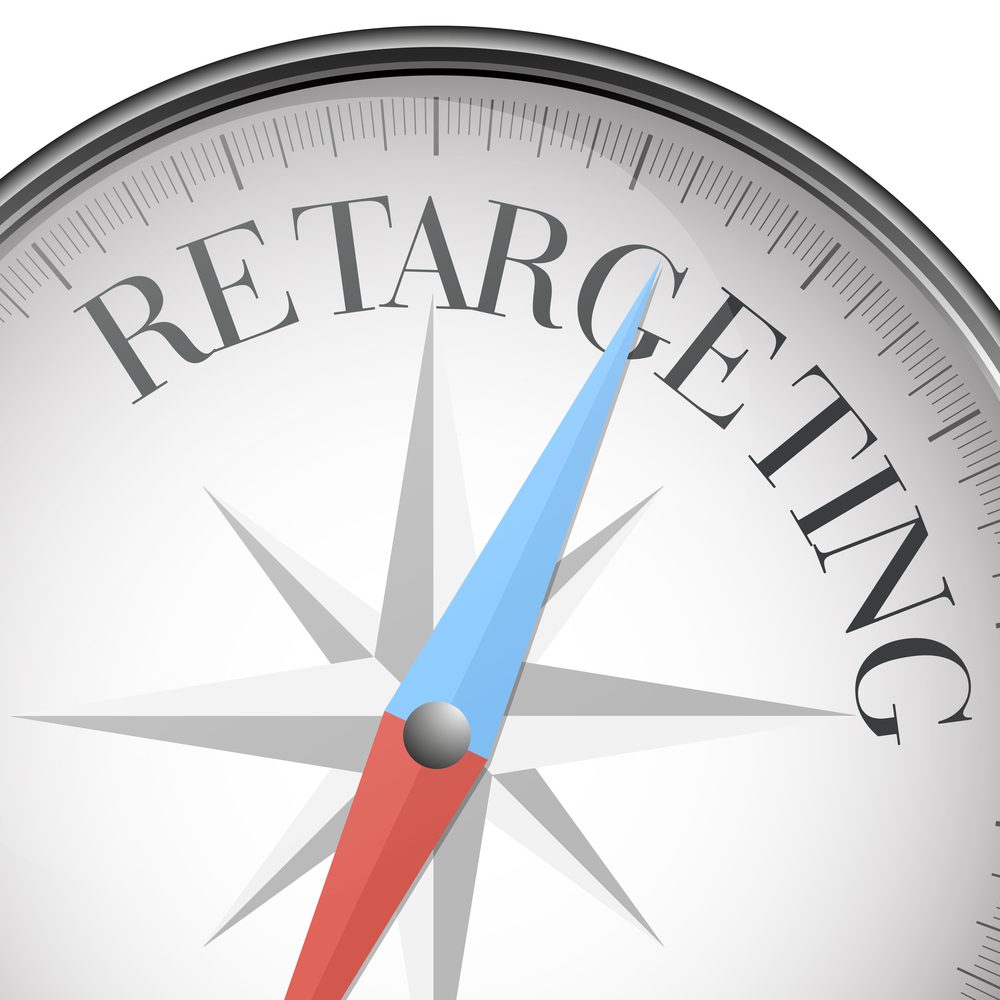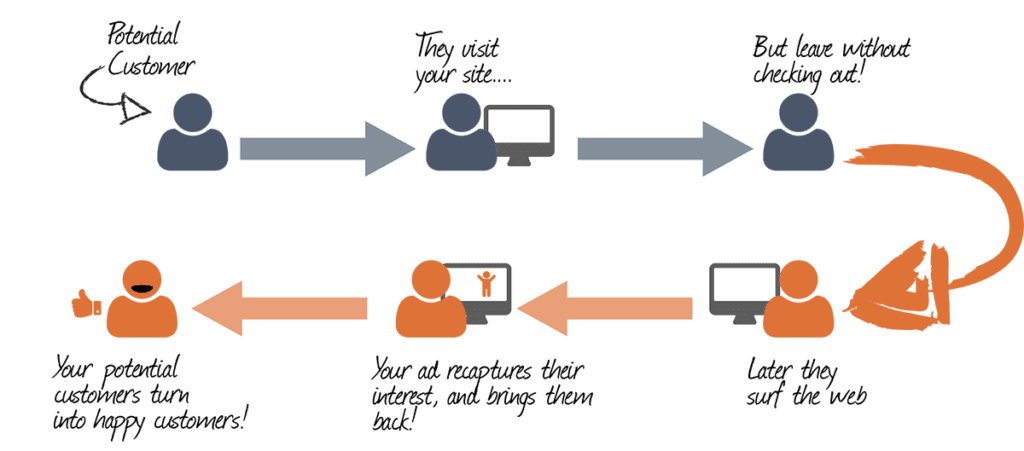
Retargeting campaigns. You’ve probably heard the term before, but maybe what they are and how they work is still a mystery to you. If that’s the case, you’ve come to the right place.
In this blog post, we’ll demystify the entire retargeting process. We’ll explain what it is and why it’s been known to work so well for businesses. We’ll also take you through the necessary steps you’ll need to follow in order to successfully run your own retargeting campaigns.
Sound like a plan? Good, let’s get started!
What Is Retargeting?
Have you ever been on social media or surfing the web and seen advertisements for a product you were just recently researching? It could be anything — a new pair of shoes, cooking utensils, an enterprise level SaaS product. As soon as you view that product online, you suddenly start to see it everywhere.
The truth is, we’ve all experienced this “phenomenon.” In the beginning you might have found it a bit disconcerting. But as it kept happening, we’re guessing you started to accept it as just another facet of using the internet. Maybe you even appreciate seeing these ads as they remind you about specific products you’re interest in.
This is what we call a retargeting campaign (AKA remarketing) and it’s been a popular tool in the marketer’s tool belt for a while now. Here’s how it typically works:
First, marketers place a small piece of Javascript code on their company’s website. This code is often referred to as a pixel and has no discernible effect on the performance of the website it’s added to.
But this pixel is powerful! Everytime a visitor views the website, the pixel will drop an anonymous browser cookie, which can be tracked by retargeting platforms. Specific ads will then be displayed to the viewer as they browse the internet.
Here is a great little graphic from Retargeter that illustrates the process:

Though this pixel based approach is by far the most popular retargeting option, there are a couple of other ways to do it. We’ll discuss them in a later section of this post.
Why Retargeting Campaigns Work So Well
The benefits of retargeting campaigns are probably pretty clear. But we’ll share some numbers to really drive the point home. If you’re currently on the fence about using this marketing technique, you won’t be for much longer.
Did you know that only 2% of website visitors convert on their first visit? It’s kind of depressing. Fortunately, retargeting campaigns are here to save the day. Website visitors who see retargeted ads after viewing a website are 70% more likely to convert. Much better!
But why is this true? Because the “rule of seven” in marketing circles still applies. If you’re unfamiliar with this classic principle, it states that the average prospect needs to see your marketing message at least seven times before they’ll take action and make a purchase.
Retargeting campaigns allow your company to stay top-of-mind with customers and be the number one choice when they’re finally ready to buy. And because this marketing technique only targets those who have interacted with your brand before, it sees a high success rate.
How to Run a Successful Retargeting Campaign
Ready to start running your very own retargeting campaigns? Great! Follow the steps in this guide and you’ll have no trouble re-engaging lost prospects.
Know Your Goals
There are two main goals you can have when preparing your retargeting campaigns: awareness and conversion. Let’s look at each more closely.
-
Awareness:
This goal is generally the easiest to achieve and will require the least amount of work on the part of a marketer or business owner. Basically, with this type of campaign, you’re just hoping to stay at the forefront of your prospects minds.
This is not a hard-sell campaign. Rather, your mission is to gently encourage prospects to re-engage with your brand and return to your website.
You can do this by promoting a blog post or video on your website, for example. Something that the prospect will find interesting and nudges them into your funnel; without shoving your products in their face.
-
Conversion:
You can also run retargeting campaigns with the goal of conversion. This goal is exactly as it sounds: turn prospects into customers. Get them to buy your stuff.
Typically, you only want to target people with conversion ads if they’ve already engaged with your brand in a tangible way — they downloaded an ebook, attended an online training, spoke with a sales rep, etc.
These ads need to be very targeted at specific actions. Did a prospect abandon a full cart? Your retargeted message could encourage them to finish checking out. Maybe they spent a significant amount of time on a product page. Show them an ad for a free trial.
Whatever you do, if conversion is the goal of your retargeting campaign, keep it focused.
Choose Your Platform
Once your goals are clearly defined and agreed upon, it’s time to choose the platform (or platforms) you’ll use in your retargeting efforts. There are a couple different options:
-
Google:
There are other display advertising networks out there. And, depending on your business, you may want to experiment with retargeting campaigns on those platforms as well.
But Google is the big fish. Also, by using Google’s Adwords platform, you’ll be able to incorporate YouTube into your remarketing campaign strategy, too!
-
Social Media:
Facebook is the major player here. But retargeting campaigns can also be run on other social networks like Instagram (via Facebook), Twitter, and LinkedIn. The social site(s) you choose will depend on where your ideal audience spends their time online.
Target Your Ideal Audience
Speaking of your ideal audience, let’s talk about targeting them effectively. Just as you (hopefully!) segment your email list and send different messages to each fraction of your audience, retargeting campaigns can be segmented as well. You can:
-
Segment By Behavior:
Segmenting by behavior is very important because different prospects will interact with your brand in different ways. Those who only take a quick look at your company’s website before clicking the back button generally aren’t worth retargeting. They haven’t shown enough interest in what you offer.
On the other hand, prospects who spend a significant amount of time on your site, comb through multiple pages, or download resources are prime candidates for retargeting campaigns. They exhibit the exact behaviours you’re looking for.
-
Segment By Time:
Time segmentation is an extension of the behavioral type we just mentioned. The actions a prospect takes on your website should determine how soon you attempt to retarget them and how often. Here’s an example:
Let’s say that both Sally and George recently visited your company’s website. Sally showed an extremely high level of interest, spending a significant amount of time on a product page. She even added the product to her cart, but left the site before completing her purchase.
In this scenario, you might want to show a retargeted ad to Sally immediately and with a consistent frequency in the hopes that she’ll return to finish what she started.
George, on the other hand, landed on your website and spent a few minutes researching your offerings before making his way back to Google. He showed moderate interest and a retargeting campaign aimed at him is a wise bet.
But because his interest wasn’t nearly as high as Sally’s, you may decide to only begin showing him ads a few days after his initial interaction with your brand. You don’t want to overwhelm or annoy him.
-
Segment By Relationship:
You also need to segment your retargeting campaigns by relationship. Meaning that prospects who already have a history with your brand — current customers, email list subscribers — should be separated from those who don’t.
Perhaps your company has decided to release a new product. Would you market your new offering to current customers the same way you would to brand new prospects? Probably not. Your retargeting campaigns need to reflect this difference in approach.
Also, you may want to occasionally target just your existing customers with ads to help maintain brand awareness. That way your company is still be top of mind when they consider the brands in your industry.
Nail Your Messaging
We’ve cover a lot so far. Now it’s time to discuss the actual writing of your retargeting campaigns! Here are a few things to keep in mind:
-
Match Your Message to Your Audience:
Who are you aiming your retargeting campaigns at? Prospects who’ve shown high levels or interest? Current customers excited by your company’s new offering?
The first step when writing your retargeting campaigns is to understand who you’re trying to reach. Then you can perfectly cater your ads to them. If you want to be successful, you need to write alternate copy for every single segment of your audience.
-
Write Great Content:
Just like any other piece of marketing material your company creates, your retargeting campaigns need to be well written. That means you need an attention grabbing headline, enticing (and brief) ad copy, and a strong CTA that motivates the reader to take action.
And since we’re on the topic of great content, it should also be mentioned that the landing page your ad directs prospects to also needs to be exemplary. Do not — we repeat DO NOT — just direct ad clickers to your company’s website home page!
This is a common, and often costly, mistake. If your ad promotes a product, then it should direct viewers to that exact product page. The only time a home page redirect might work is for simple awareness campaigns.
-
Get the Visuals Right:
If an image is worth a thousand words, you really need to get this aspect of your retargeting campaigns right! Whether you choose to use a photo or video, make sure it matches the copy of your ad and your company’s branding.
Also, your image needs to be eye-catching. Don’t bore viewers with dull colors and sub-par visuals. Make it exciting to look at!
Track Your Results
Once your retargeting campaigns have been created and released into the wild, it’s time to track their results and optimize them appropriately.
Don’t beat yourself up if the first iteration of your ad performs poorly — especially when you’re first getting started with retargeting. It’s a process and even experienced marketers need to optimize for the best results.
With that in mind, here’s what to look for during the optimization process.

-
Top Metrics:
Whether you’re running your retargeting campaigns on Google, Facebook, or some other platform, you’ll be provided with some kind of stats dashboard. This is a gold mine of information.
Pay special attention to your CTR (click through rate), CPC (cost per click) and ROI (return on investment). These are important numbers as they show how often your prospects are responding to your ads (CTR), how much each click is costing your business (CPC) and how beneficial the ads are in general (ROI).
What if your results are less than desirable? Let the optimization begin. This is where mediocre ads become winners and great ads become legendary. When attempting to optimize your retargeting campaigns, first make sure your segmentation is on point.
Then look at improving your actual ad. Ask yourself, is our headline drawing prospects in with an enticing benefit? Is our body copy brief and to the point? Is our CTA clear and does it promote action? If the answer is no to any of these questions, change things up.
What if your CTR is stellar, but your ROI is disappointing? It sounds like you may need to optimize your landing page. Just remember, whenever you’re engaged in an optimization effort, only change one aspect of your ad at a time.
More than that and you won’t know the exact reason for a change in results.
-
Use Burn Codes and Frequency Caps:
If you want to annoy your customers, send them retargeted ads for products they’ve already purchased. Or don’t, since none of us are in the business of “biting the hands that feed us.”
Instead, use burn codes. These are small bits of code you can add to any web page that represents a conversion. A thank you page, for example. When a person reaches this page they’ll automatically be removed from your list and no longer served retargeted ads.
You should also add frequency caps to your retargeting campaigns. A frequency cap, as its name implies, limits the amount of times a prospect sees your retargeted ads within a specific time frame.
We advise a maximum of 20 impressions per 30 day interval. If a prospect sees your ad more than 20 times in a month, they might become irritated. They’re also not likely to convert. So hold back and don’t overdo it.
-
Rotate Ads Consistently:
One way to combat “ad fatigue” is to rotate the ads you serve to your audience. You don’t need a hundred different ads; three to five will do nicely. Just make sure that each ad in each of your retargeting campaigns has the same goal. Then you can compare them and see which one converts better.
Two More Techniques for Your Retargeting Campaigns
Most of this article has been focused on the what and how of pixel based retargeting campaigns. But we’d be remiss if we didn’t mention another two types as well. While not as popular, they can still provide tremendous value for your business.
Email Based Retargeting Campaigns
If your company uses email marketing to help promote its products, then email based retargeting could prove very effective.
Here’s how it works: first you upload your company’s email list to your platform of choice (Google, Facebook, etc.). Then the platform will show your retargeting campaigns to those specific users who’ve logged into their service using the given address.
We’re sure you have plenty of names on your list who haven’t purchased any of your products. They signed up to receive new blog notifications or traded their email in exchange for access to a lead magnet.
Take direct aim at these prospects in future retargeting campaigns by using an email based approach.
Link-Based Retargeting Campaigns
Once you’ve become comfortable with the standard, pixel based retargeting method, you may want to start running link based retargeting campaigns.
Basically, a link-based approach allows you to add your tracking pixel to any URL that you control. When a prospect clicks on the link — even if they’ve never visited your company’s website before or the link leads to a site other than yours — you can add them to your retargeting campaigns.
It may sound strange, but it’s perfectly legal. And it will allow you to expand your retargeting efforts at a much faster rate — 500% according to Rebrandly!
Hit the (Re)Target
Retargeting campaigns may be just the thing your marketing efforts need. Especially if you’re not seeing anywhere near the conversion metrics you’d like.
But remember, in order to use this technique effectively, you must first choose your campaign goal and the platform you’ll use to achieve it. Then spend time really honing in on your ideal audience. There’s no point in retargeting bad leads.
When you sit down to write the actual ads, make sure to create great content that matches the audience you’re hoping to reach, and include eye-catching visuals. When all of these elements come together and are paired with consistent optimization efforts, we’re confident you’ll see a high level of success with your retargeting campaigns!
Have you attempted any retargeting efforts yet? What was the most difficult aspect for you and how did you overcome it? Give us the details in the comments below.
Jacob Thomas is a freelance copywriter and content marketer based in Bend, OR. His professional writing approach has helped numerous businesses gain more traffic, leads, and sales. To contact Jacob, visit www.jtcopywriting.com.



